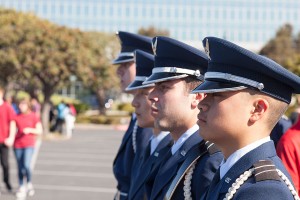Students in ROTC take different path
While many students spend their four years of college doing a combination of studying and socializing, others enrolled in USC’s Naval ROTC, Army ROTC and Air Force ROTC training programs dedicate their educations to a different cause.
“I felt that there was something more out there for me my senior year of high school,” said Leon Sung, a senior majoring in kinesiology. “Being part of a team and working to accomplish something really appealed to me.”

Aim high · Students in USC’s Air Force ROTC stand at attention during the Southern California Invitational Drill meet, which was held in Redondo Beach in March 2013. – Ralf Cheung | Daily Trojan
Sung is currently a cadet training officer and is responsible for planning and organizing task conditioning standards for the cadets he supervises. As the task force north commander, he also works with students at California State University, Dominguez Hills, in planning programs for students there and at USC.
Eyobed Mesfun, a sophomore majoring in economics, however, joined the military program for entirely different reasons.
“I’ve always wanted to get into government and politics, either through the military or through the civilian world,” Mesfun said.
Students in NROTC and ROTC programs have workouts known as PT, or physical training, on Monday, Wednesday and Friday mornings from 6:20 a.m. to 7:30 a.m.
The program also includes Friday labs after the workouts, when the cadets take part in leadership activities, including squad tactics and techniques to handle chaotic situations and remain calm.
“Right now I’m just focusing on learning as much as possible and figuring out exactly what I’m going to do and my role in the program,” Mesfun said.
Students in the program are also required to take a military science class every semester that varies from two to four units. Additionally, they are required to participate in a Leadership Development Exercise once a semester, which focuses on “building more mentally agile and adaptive leaders,” according to Sung. Other exercises include the Ranger Challenge, a skills competition for cadets.
“You also have the traditional ROTC extracurriculars, such as color guard — we protect the American flag and display it during football games,” Sung said.
According to Sung, the Army ROTC is the largest branch, with opportunities that include specialty schools, promotions and various duty locations.
“Across the organization, people truly are professionals,” Sung said. “We have one standard set of army values.”
Though those in the programs share the same values, students find their own niches in each branch. For example, according to Mesfun, students in the Air Force program are typically resigned to engineering.
“Most of the roles [the Air Force has] are support roles and they are not in the field conducting operations and tasks,” Mesfun said.
Mesfun himself was originally part of the Air Force program, but switched into the Army because he felt it was a better fit for him.
“I wanted to just have a more hands-on role in my military activity and my career,” he said. “I realized if I was going to be an Air Force officer I would be really limited in what I would be able to do in the field.”
As students get older, they acquire more responsibilities within the program. Seniors are responsible for helping to run the program.
“Sophomores and freshman are typically more like sponges, and they’re just there to absorb and learn,” Mesfun said.
Even though he has only been part of the Army program for two months now, Mesfun said that he felt welcomed by his fellow students.
“We’re all part of a pretty tight-knit group, and they welcomed me pretty quickly,” he said.
Though each branch is part of the military, the branches tend not to work together.
“Each program is designed to work completely independently from the other programs,” Sung said.
Many branches have started to work alongside each other, but it is difficult because of the different training standards in each branch.
Mesfun said he felt the different branches had different specializations.
“I feel like Army’s more focused on the physical aspect and well-roundedness while Air Force is more focused on managerial and logistics and background information to support everything,” he said.

